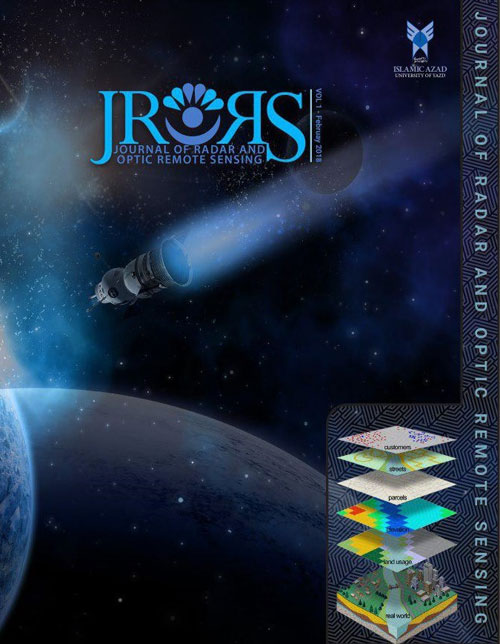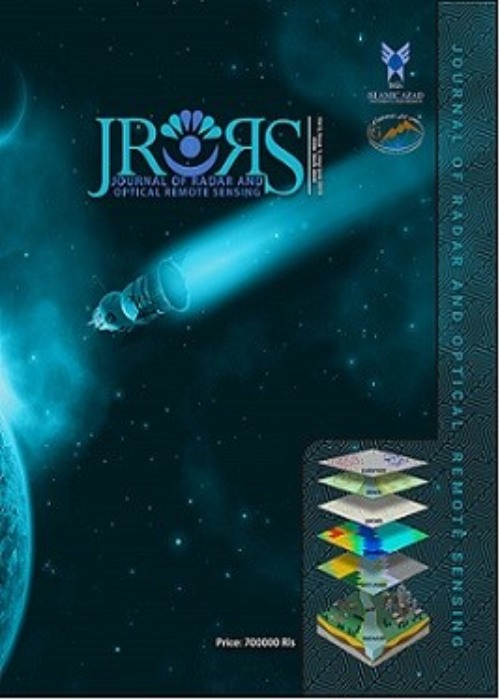فهرست مطالب

Journal of Radar and Optical Remote Sensing
Volume:1 Issue: 2, Autumn 2018
- تاریخ انتشار: 1397/03/12
- تعداد عناوین: 6
-
Pages 7-23Remote sensing provides data types and useful resources for forest mapping. Today, one of the most commonly used application in forestry is the identification of single tree and tree species compassion using object-based analysis and classification of satellite or aerial images. Forest data, which is derived from remote sensing methods, mainly focuses on the mass i.e. parts of the forest that are largely homogeneous, in particular, interconnected) and plot-level data. Haft-Barm Lake is the case study which is located in Fars province, representing closed forest in which oak is the valuable species. High Resolution Satellite Imagery of WV-2 has been used in this study. In this study, A UAV equipped with a compact digital camera has been used calibrated and modified to record not only the visual but also the near infrared reflection (NIR) of possibly infested oaks. The present study evaluated the estimation of forest parameters by focusing on single tree extraction using Object-Based method of classification with a complex matrix evaluation and AUC method with the help of the 4th UAV phantom bird image in two distinct regions. The object-based classification has the highest and best accuracy in estimating single-tree parameters. Object-Based classification method is a useful method to identify Oak tree Zagros Mountains forest. This study confirms that using WV-2 data one can extract the parameters of single trees in the forest. An overall Kappa Index of Agreement (KIA) of 0.97 and 0.96 for each study site has been achieved. It is also concluded that while UAV has the potential to provide flexible and feasible solutions for forest mapping, some issues related to image quality still need to be addressed in order to improve the classification performance.Keywords: Separation of single trees, Canopy, Remote Sensing, Classification, Zagros forests, Haft-Barm of Shiraz
-
Pages 24-37Fusions of panchromatic and multispectral images create new permission to gain spatial and spectral information together. This paper focused on hybrid image fusion method FFT-PCA, to fuse OLI bands to apply Dimensionality Reduction (DR) methods (PCA, ICA and MNF) on this fused image to evaluate the effect of these methods on final classification accuracy. A window of OLI images from Ardabil County was selected to this purpose and preprocessing method like atmospheric and radiometric correction was applied on this image. Then panchromatic (band8) and multispectral bands of OLI were fused with FFT-PCA method. Three dimensionality reduction algorithms were applied on this fused image and the training data for classification were selected from DRs Output. A total of eight classes include bare land, rich range land, water bodies, settlement, snow, agricultural land, fallow and poor range land were selected and classified with support vector machine algorithm. The results showed that classification based on dimensionality reduction algorithms was quite good on OLI data classification. Overall accuracy and kappa coefficient of classification images showed that ICA, PCA and MNF methods 86.9%, 89%, 96.8% and 0.84, 0.91, 0.96 respectively. The MNF based image classification has higher classification accuracy between two others. PCA and ICA have lower accuracy than MNF respectively.Keywords: Hybrid fusion, FFT-PCA, Dimensionality reduction algorithms, support vector machine
-
Pages 38-54The earth surface is itself a complex system, and land cover variation is a complex process influenced by the interference of variables. In this study, the data of Sentinel 2 for 2017 and 2016 were processed and classified to study the changes in the Andika area. After discovering vegetation changes between two images over the mentioned time, vegetation increased by 661.74 hectares. Multiple regressions have been used to identify factors affecting vegetation changes. Multiple regressions can explain the relationship between vegetation changes and the factors affecting them. In order to investigate the factors affecting vegetation change, altitude data, distance from the road, distance from residential areas of the village and river were introduced into regression equation. Since this method uses three parameters such as Pseudo-R2 and Relative Operation Characteristic (ROC(, 0.23, and 0.696 values for the above parameters, which indicates that the model is in good agreement. The results of regression analysis show that linear composition of height variable as independent variables in comparison with other parameters has been able to estimate vegetation change. Subsequently, by using two classified pictures of 2017 and 2016, the amount of vegetation changes was calculated, and Markov chain method was used for 2018 forecast changes.Keywords: NDVI, Sentinel 2, Cellular Automata Markov, logistic regression
-
Pages 55-66Soil Salinization is one of the oldest environmental problems and one of the main paths to desertification. Access to information in the shortest time and at low cost is the major factor influencing decision making. The satellite imagery provides information data on salinity and also offers large amount of data that can be analyzed and processed to understand several indices based on the type of the sensor used. In this research, the capability of different indices derived from IRS-P6 data was evaluated to identify saline soils in Mahabad County. The quality of the satellite images was first evaluated and no noticeable radiometric and geometric distortion was detected. The Ortho-rectification of the image was performed using the satellite ephemeris data, digital elevation model, and ground control points. The RMS error was less than a pixel. In this study, the correlation between the bands and used indices, including Salinity1, Salinity2, Salinity3, PCA1 (B2, B3), PCA1 (B4, B5), PCA1 (B1, B2, B3, B4, B5), Fusion (Pan and B2), Fusion (Pan and B3) and Fusion (Pan and B4) with EC were investigated. The highest correlation was related to the Fusion (Pan and B2) with a coefficient 0.76 and the lowest correlation was related to B4 with a coefficient 0.2. The results showed that the indices have a high ability for modeling, mapping and estimating the soil salinity.Keywords: Indices, IRS-P6, Remote Sensing, Soil Salinity
-
Pages 67-78The main reason for subsidence in Iran is the large amount of water withdrawn from underground resources, which, if not managed properly will cause irreparable damages. To deal with such a problem, it is necessary to identify the subsidence areas. Most country's ancient artifacts have been built on fertile plains, and due to the dryness of the past decade, and the abundance of groundwater from the subsidence, it accelerates the destruction of ancient works in these areas. In this research, the area of Persepolis, which is 57 km northeast of Shiraz and 10 km north of Marvdasht city, is based on the level of the land subsidence using differential radar interferometry technique. Using Eoli-SA 9.4.3 software, two images were taken from the ASVAR data series of the ENVISAT satellite. The data processing with SARSCAPE 4.3 software, a radar differential interference method, has been implemented at two different times in a region. A new image called an interferogram or interferometer was provided that contains the target geophysical information. Therefore, the amount of subsidence or uplift was determined in the three interlaced states. During the research period from 23/12/2004 to 17/12/2009, which is 1820 days, it has been clear that the ancient area of Persepolis, the historic city of the pool and the role of Rustam between two and three centimeters subsided, and the role of Rajab is also between the four has seen up to five centimeters of subsidence.Keywords: Geotechnical, Radar interferometry, Subsidence, Persepolis
-
Pages 79-93Many varied attitudes exist about how the changes occur in the land-surface from the time of William Davis’s research to the latest researchers in the history of geomorphologic philosophy and many different terms are used by scientists in order to observe their ideas related to geomorphic phenomena. The phenomenon of duality has been seen less in the geomorphology field. There exist some contradictory phenomena in nature, but further investigation can show their correlation clearly. Durability can be considered as a better dynamic entropy. In this research, radar interferometry technique has been used in Yazd-Bahadoran area and the amount of subsidence and uplifting has been investigated Through field and library studies and the results have been compared with the other researchers' studies, which is a new concept in the literature of geomorphology under geo-duality. The study results indicate that the main reason for the subsidence was not to cut down the level of groundwater, and in this regard the tectonic movements play a significant role. Also, the study shows a significant relationship between subsidence in the Bahadoran plain and the collapse in adjacent heights in terms of duality or dichotomy.Keywords: Subsidence, uplifting, duality, geomorphology, radar images


